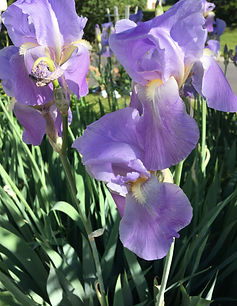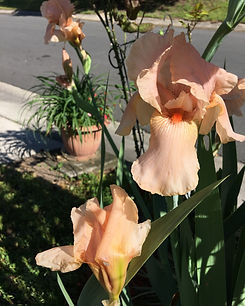
DENNIS PLANT GARDEN
Plant Care & Information
IRISES Bearded Irises
(Iris Germanica).
%20IRS.jpg)
Irises are an easy-to-grow perennial plants with elegant, colorful flowers. These plants, when in full bloom, brightens up any garden and it catches the eye of everyone when planted in certain areas around the yard. Despite its divine origins, it is hardy, reliable, and easy to grow. Irises also attract butterflies and hummingbirds, and they make lovely cut flowers
Irises come in many different sizes, some as short as six inches and others can grow up to four feet.
-
Dwarf varieties 6 to 12 inches tall and wide
-
Dutch varieties 1-1/2 to 2 feet tall and 6 to 12 inches wide
-
Tall bearded varieties range from 2 to 4 feet tall and 1-1/2 to 2 feet wide
Do not use Mulch on top of rhizomes or near the foliage as it can cause rot. For reblooming varieties, apply a light application of fertilizer following the first bloom and water regularly during summer dry periods for an improved second bloom in fall.
When to Plant:
The best time to plant iris rhizomes or bulbs is late summer to early autumn to allow them plenty of time to establish roots before the growing season ends. In hotter climates, plant in September or October.
Amendments & Fertilizer:
Apply a low-nitrogen fertilizer a month before bloom time. Do not use Mulch on top of rhizomes or near the foliage as it can cause rot. For re-blooming varieties, apply a light application of fertilizer following the first bloom and water regularly during summer dry periods for an improved second bloom in fall.
Watering:
Irises generally have low water requirements once established but can use a little extra if unusually dry just before bloom time. Louisiana, Siberian and Japanese irises need more water than the bearded types.
Propagation:
Growing Irises from seed may take a couple of years before they fully bloom. Most often, propagation is by division of the bulbs or rhizomes (dig them up and divide the Irises in late summer or early fall.
Diseases and Pests:
Irises can be severely damaged by iris borers and thrips if not controlled. White-flies, slugs, snails, aphids, and nematodes may also be a nuisance. Deer will seldom harm irises but may occasionally bite off the blossoms of the crested types, although will usually spit them out and leave them behind. Bacterial leaf blight, rhizome rot, leaf spot, rust, and viruses may affect the Irises
WARNING:
All parts of irises may cause severe discomfort if ingested. Ware gloves when handling iris plants, rhizomes, or bulbs, as the sap can cause skin irritation.
%20Lan.jpg)
Hardness Zones:
Generally, iris thrive in USDA Hardiness Zones 3 through 10 in the dry-summer West and in 3 through 8 in the rainy-summer East. Varieties suitable for zones 3-9
Propagation:
Growing Irises from seed may take a couple of years before they fully bloom. Most often, propagation is by division of the bulbs or rhizomes (dig them up and divide the Irises in late summer or early fall.
Bloom Time:
Most irises will bloom in mid-spring or early summer. Dwarf varieties tend to bloom earlier in spring, with intermediate sizes blooming later spring, and taller bearded varieties blooming late spring and summer. Re-blooming varieties will produce flowers once in summer and again in fall.
Color:
There is an extremely wide variety of colors, ranging from white to almost black; although most common in shades of lavender, purple, white and yellow
Where to Plant:
Choose a sunny location for your irises where they won’t be subject to standing water, (On a Hill/slope is best, in that water runs off). Raised beds are ideal for growing irises, as they provide the good drainage needed.
How to Plant:
Prepare the planting beds up to two weeks ahead by loosening soil to a depth of 10-12 inches to establish good drainage. At this time, organic matter can also be mixed in. Plant Iris rhizomes so that they are slightly visible on the soil surface, or thinly covered in warmer climates. They can be top dressed with a low-nitrogen fertilizer,
avoid high-nitrogen as it can cause rot). Make 2 rows in the soil with a small ridge in between. Place the rhizome on the ridge and spread the roots to either side. Most irises prefer average to fertile, neutral to slightly acidic, well-drained soil. However, Japanese irises prefer lime-free soil.
Maintenance:
Cut back the flowering stalks after flowering, but leave the foliage intact so it can continue to gather and store nutrients and energy for the following season. Trim leaves off at ground level after they turn yellow in fall; this will reduce the possibility of overwintering diseases or bugs/pests.
Dividing Iris Rhizomes:
Rhizomatous types need dividing every 3-5 years, typically soon after bloom time. A reduction in blooming or rhizomes, when pushed up out of the soil can be signs that it’s time to dig them up and divide. If this is a dividing year, don’t cut the foliage back - so you know where they are. Dig the rhizomes up carefully and divide them by pulling apart with your hands. Some, however, may need cuting with a knife. Healthy rhizomes will be approximately ¾ to 1-inch in diameter, with a good root structure and one to two leaf fans. Older or unhealthy (soft, rotting, or hollow) rhizomes should be discarded. Wash the roots with water and inspect for disease or pests, especially iris borer worms. Trim the leaves to 4 to 6 inches and re-plant as above, with the rhizome on a ridge and roots fanned out. Water newly planted irises well.


%20IRS.jpg)
%20IRI.jpg)
%20Lan.jpg)
%20IRI.jpg)